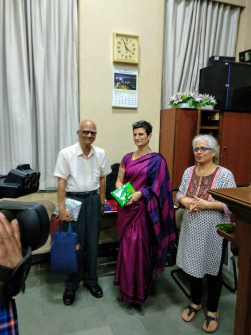
The 10th lecture in the Krishna Raj Memorial Lecture series on Contemporary Issues in Health and Social Sciences was delivered by Dr Sarah Hodges at the MLT Hall, KEM Hospital, Mumbai on September 18 2019. The lecture series was instituted by Anusandhan Trust to honour the memory of Krishna Raj, editor of Economic and Political Weekly who passed away in harness in 2004. Sarah Hodges is a scholar of socio-cultural history of modern South Asia, specifically the politics of health in colonial and postcolonial India. The event was ably hosted by the Centre for Health and Allied Themes (CEHAT) Mumbai with the Humanities Department of KEM Hospital and eSocialSciences.
Dr Hodges drew a shocking picture of how medical plastic waste accumulates and has been growing in volume over the decades. Ostensibly, it is the adoption of hygienic practices that has prompted the use of disposables that has in turn, led to huge upsurge in the volume of plastic generated in every hospital and medical care facility. So much so that today plastics, by volume, are the highest contributors to hospital waste everywhere in the world.
Plastics made inroads into the medical world from the 1960s onwards when newer methods of manufacture enabled the production of components suitable for medical care. Plastic syringes took over glass and was most notably significant in the delivery of the polio vaccine. With the Korean War, plastic blood bags became ubiquitous and by the 1980s plastics had made inroads into most areas of medical practice. At this point of time, the raison d’etre for the use of plastics was not so much hygiene as it was patient comfort. This increasing use of plastics also made it possible to make changes in personnel duties---sterilising of equipment and autoclaving were no longer required. In other words, the use of plastics led to changes in the organisations of the medical system.
The follow through of this invasion of plastic in the western medical establishment was that patient demand for reusable and so, safer alternatives began to build up in countries like India, where the use of single use plastics appeared to be an easy way out of poor hygienic practices. This has had grave consequences: instead of persisting in developing a robust sanitary practice, the medical establishment gave up on the endeavour and took the easier way out by adopting plastics.
What is the half life of such plastics? What is their life cycle? While some of the plastic garbage gets questionably refurbished for reuse and resale, the more profitable route is reprocessing which is a burgeoning industry and is the more lucrative path. The enormous impact of the increasing and rampant use of plastics in medicare needs to be examined more closely and contained.
In sum, the use of plastics has changed the entire environment and the larger socio economics. What is the solution? Is there a solution? Can we go back to the days of glass equipment ad rubber tubing? These were the questions that the audience was left pondering at the end of the lecture. The enormous problem of hospital waste and its plastic component is clearly not an easily addressed one. And this lecture prompted questions, that though not easy to answer, led to a building of awareness.
Posted on :
Sep 22, 2019